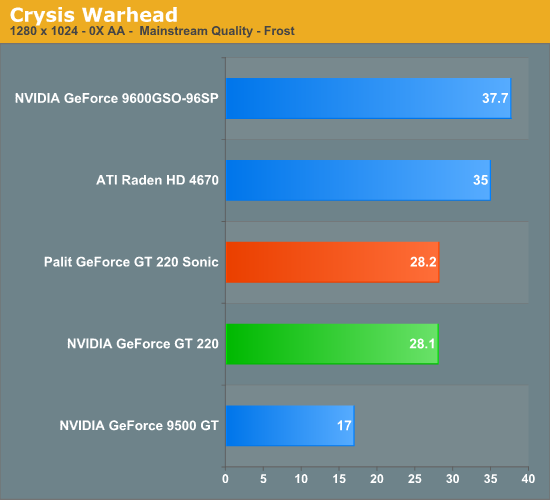NVIDIA’s GeForce GT 220: 40nm and DX10.1 for the Low-End
by Ryan Smith on October 12, 2009 6:00 AM EST- Posted in
- GPUs
Crysis: Warhead
Kicking things off, we’ll start with Crysis: Warhead. Warhead is still the single most demanding game in our arsenal, with even high-end cards continuing to struggle to put out a playable frame rate with everything turned up.
For testing these low-end cards, we have deviated some from our normal testing. These tests were done with Mainstream graphics quality at resolutions more appropriate for these cards.


The last card we ended up testing for this article was the 4670, and the moment we ran this benchmark it basically killed any enthusiasm we had for the GT 220. The GT 220 is not competitive here with the 4670, which is its slightly cheaper competition from AMD.
If there is a bright side, Crysis does run decently even on the GT 220 after turning down the quality settings to Mainstream.










80 Comments
View All Comments
Ryan Smith - Monday, October 12, 2009 - link
I don't have that information at this moment. However this is very much the wrong card if you're going scientific work for performance reasons.apple3feet - Wednesday, October 14, 2009 - link
Well, as a developer, I just need it to work. Other machines here have TESLAs and GTX280s, but a low end cool running card would be very useful for development machines.I believe that the answer to my question is that it's 1.2 (i.e. everything except double precision), so no good for me.
jma - Monday, October 12, 2009 - link
Ryan, if you run 'deviceQuery' from the Cuda SDK, it will tell you all there is to know.Another goodie would be 'bandwidthTest' for those of us who can't figure out the differences between various DDR and GDDR's and what the quoted clocks are supposed to imply ...
vlado08 - Monday, October 12, 2009 - link
My HD 4670 idles in 165MHz core and 249,8MHz memoy clock and GPU temps 36-45 degrees(passively cooled) as reported by GPU-Z 0.3.5 Is there a possibility that your card didn't lower it's clock during idle?vlado08 - Monday, October 12, 2009 - link
My question is to Ryian of course.Ryan Smith - Monday, October 12, 2009 - link
Yes, it was idling correctly.KaarlisK - Monday, October 12, 2009 - link
The HD4670 cards differ.I've bought three:
http://www.asus.com/product.aspx?P_ID=Z9qnCFnOUNDM...">http://www.asus.com/product.aspx?P_ID=Z9qnCFnOUNDM...
http://www.gigabyte.com.tw/Products/VGA/Products_O...">http://www.gigabyte.com.tw/Products/VGA/Products_O...
http://www.asus.com/product.aspx?P_ID=g6LDXHUo0EzV...">http://www.asus.com/product.aspx?P_ID=g6LDXHUo0EzV...
The first one would idle at 0.9v.
The second would idle at 1.1v. When I edited the BIOS for lover idle voltages, I could not get it to be stable.
The third one turned out to have a much cheaper design - not only did it have slower memory, it had no voltage adjustments and idles at 1.25v (but the correct idle frequency).
vlado08 - Monday, October 12, 2009 - link
Are GT 220 capable of DXVA decoding of h.264 at High Profile Level 5.1?And videos wiht more than 5 reference frames. Because ATI HD4670 can only do High Profile (HiP) Level 4.1 Blu-ray compatible.
Also what is the deinterlacing on GT 220 if you have monitor and TV in extended mode? Is it vector adaptive deinterlacing?
These questions are important for this video card because it is obvious that it is not for gamer but for HTPC.
On HD 4670 when you have one monitor then you have vector adaptive deinterlacing but if you have two monitors or monitor and TV and they are in extended mode then you only have "bob" deinterlacing.
I'm not sure if this is driver bug or hardware limitation.
Ryan Smith - Monday, October 12, 2009 - link
I have another GT 220 card due this week or early next. Drop me an email; if you have something I can use to test it, I will gladly try it out. I have yet to encounter anything above 4.1 though; it seems largely academic.MadMan007 - Monday, October 12, 2009 - link
So my inner nerd that just has to know is confused. Are these truly GT200-based or G9x-based? Different sources say different things. In a way the GT200 series was an improvement on G9x anyway but with enough significant low level changes to make it different. The article calls these GT200 *series* but that could be in name only. It's not clear if that means smaller process cut down die GT200-based or added feature G9x-based.Inquiring nerds want to know!